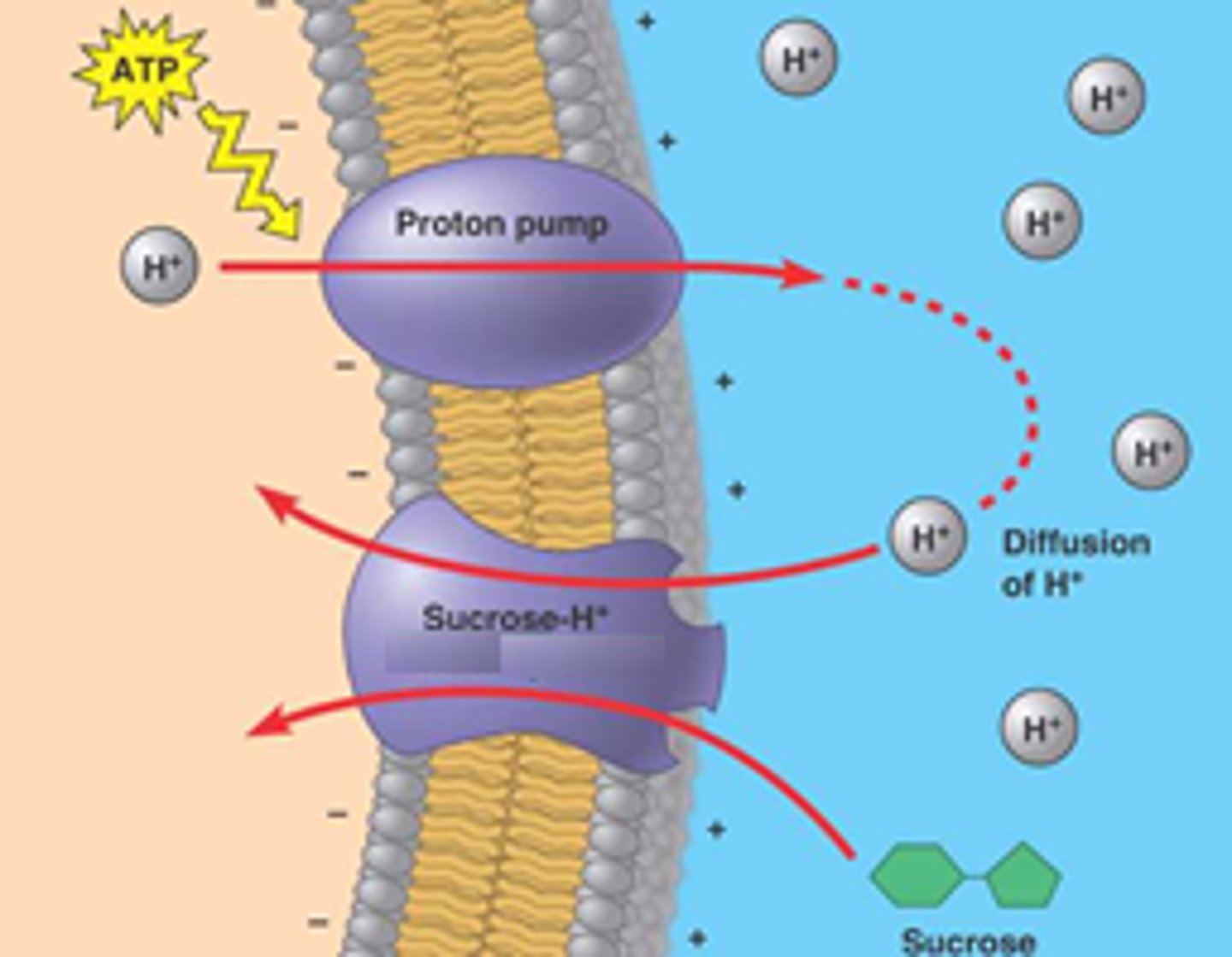Transport in Plants
1/40
Earn XP
Description and Tags
biology exchange and transport
Name | Mastery | Learn | Test | Matching | Spaced |
|---|
No study sessions yet.
41 Terms
Why do plants need transport systems?
-Plants need substances like water, minerals and sugars to live.
-They also need to get rid of waste substances.
-Plants are multicellular so have a small surface area to volume ratio. They also have a high metabolic rate.
-Exchanging substances by direct diffusion would be too slow to meet their metabolic needs. So they need transport systems.
What are the two types of tissue involved in transport in plants?
-Xylem tissue transports water and mineral ions in solution.
-Phloem tissue mainly transports sugars also in solution up and down the plant.
-Xylem and phloem make up a plant's vascular system.
What are the positions of the xylem and phloem and in the roots?
-In a root, the xylem and phloem are in the centre to provide support for the root as it pushes through the soil.
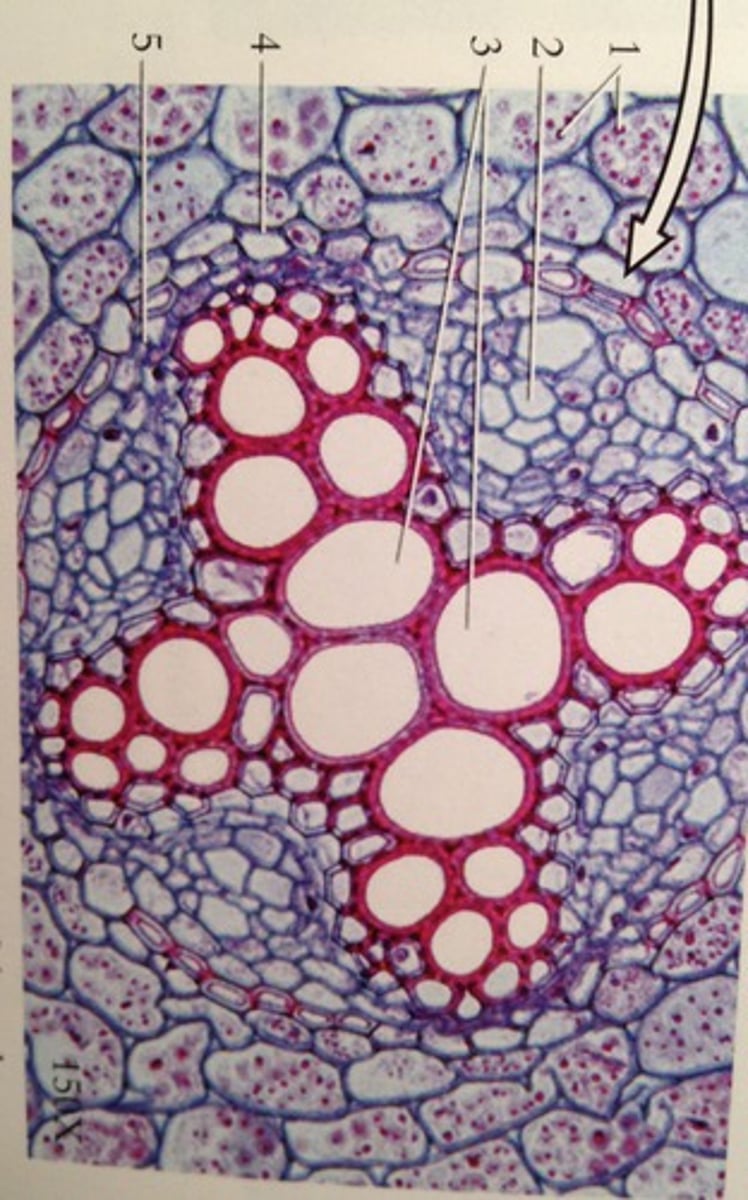
What are the positions of the xylem and phloem in the stem?
-In the stems, the xylem and phloem are near the outside to provide a sort of 'scaffolding' that reduces bending.
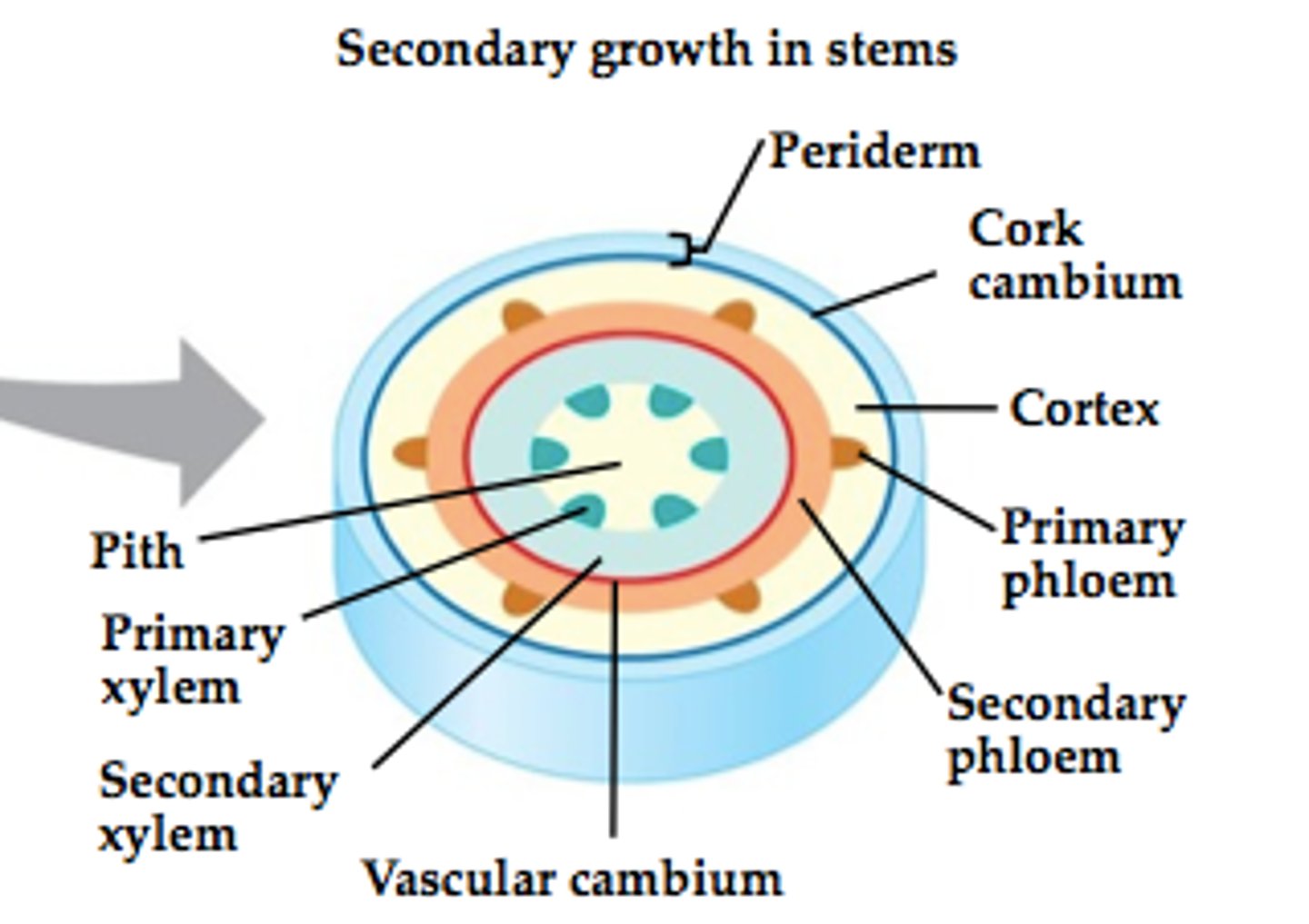
What are the positions of the xylem and phloem in the leaves?
-In a leaf, xylem and phloem make up a network of veins which support the thin leaves.
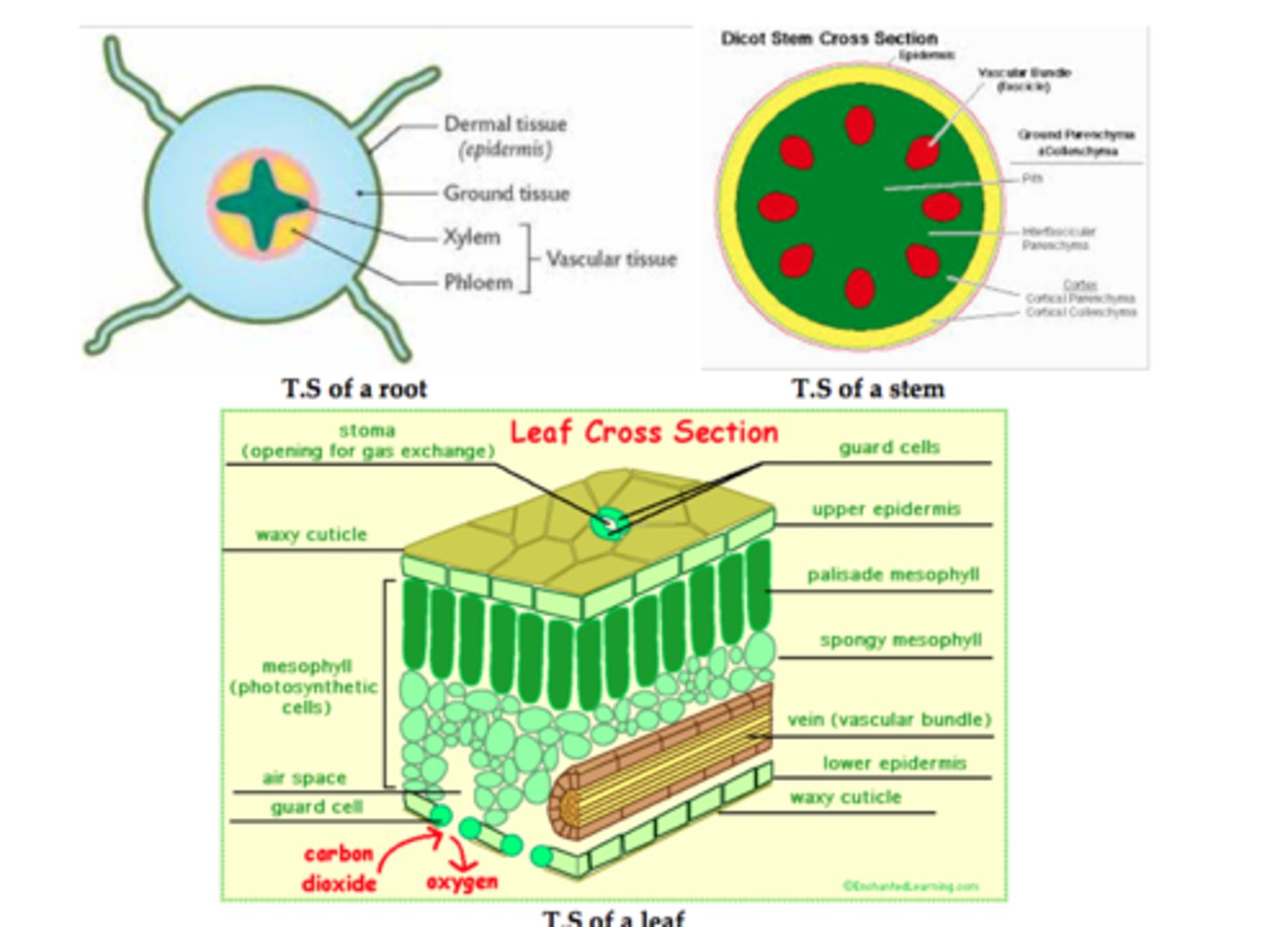
What are the adaptions of the xylem vessel?
-Xylem vessels are the part of xylem tissue that actually transport the water and ions.
-Xylem vessels are very long, tube-like structures formed from cells joined end to end.
-There are no end walls on these cells, making an uninterrupted tube that allows water to pass up through the middle easily.
-The cells are dead so they contain no cytoplasm.
-The cell walls are thickened with a woody substance called lignin, which helps to support the walls and stops them collapsing inwards.
-Lignin can be deposited in xylem walls in different ways, e.g. in a spiral or as distinct rings. Being deposited in these patterns allows flexibility and prevents the stem from breaking.
-The amount of lignin increases as the cell gets older.
-Water and mineral ions move into and out of the vessels through small pits in the walls where there's no lignin. This is how other types of cell are supplied with water.
-Thick-walled xylem parenchyma packs around the xylem vessels, storing food and containing tannin deposits. Tannin is a bitter-tasting chemical that protects plant tissues from attack by herbivores.
How is phloem tissue adapted?
-Phloem tissue transports solutes, mainly sugars like sucrose and amino acids, round plants.
-Phloem is formed from cells arranged in tubes.
-Unlike xylem, phloem is purely a transport tissue - it isn't used for support as well.
-Phloem tissue contains phloem fibres, phloem parenchyma, sieve tube elements and companion cells.
What are sieve tube elements?
-Living cells that form the tube for transporting sugars.
-Joined end to end to form sieve tubes.
-The sieve parts are the end walls, which have lots of holes in them to allow solutes to pass through.
-Sieve tube elements have no nucleus, a very thin layer of cytoplasm and few organelles.
-The cytoplasm of adjacent cells is connected through the holes in the sieve plates.
What are companion cells?
-The lack of nucleus and other organelles in sieve tube elements means that they can't survive on their own.
-So there's a companion cell for every sieve tube element. They are linked via many plasmodesmata.
-Companion cells carry out the living functions for both themselves and their sieve cells. For example, they provide the energy for the active transport of solutes.
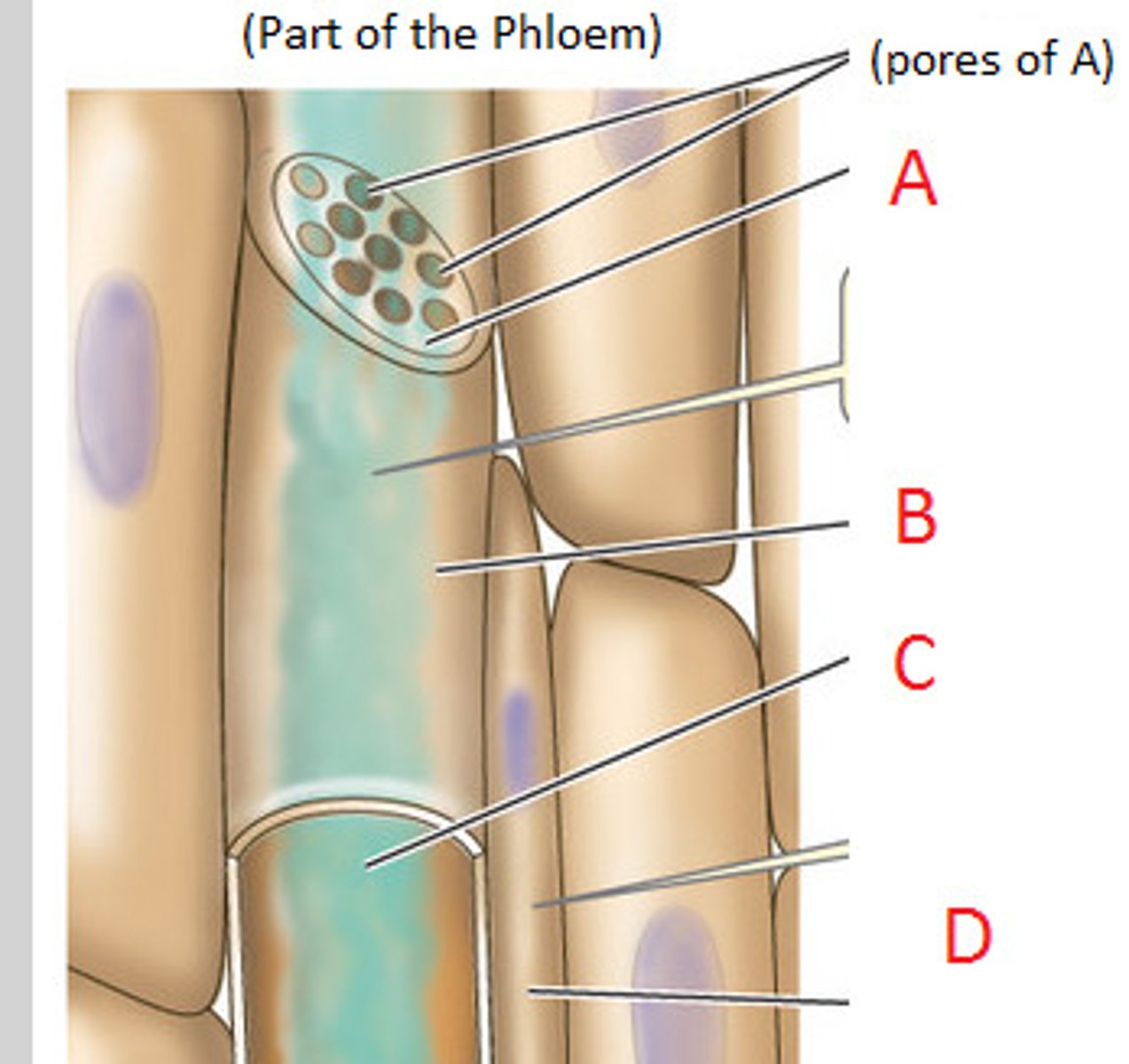
Why is water important in plants?
-Turgor pressure helps the plant keep its shape.
-Turgor also drives cell expansion - it is the force that enables plant roots to force their way through concrete.
-The loss of water by evaporation helps to keep the plant cool.
-Mineral ions and the products of photosynthesis are transported in aqueous solutions.
-Water is a raw material for photosynthesis.
How are root hairs adapted as exchange surfaces?
-Microscopic size means they can penetrate easily between soil particles.
-Large SA:V ratio.
-Thin surface layer through which diffusion and osmosis can take place quickly.
-Concentration of solutes in the cytoplasm of root hair cells maintains a water potential gradient between the soil water and the cell.
How does water enter a plant?
-Water enters through root hair cells and then passes through the root cortex, including the endodermis, to reach the xylem.
-Water is drawn into the roots via osmosis. Water always moves from areas of higher water potential to areas of lower water potential.
-The soil around roots generally has a high water potential and leaves have a lower water potential because water constantly evaporates from them.
-This creates a water potential gradient that keeps water moving through the plant in the right direction, from roots to leaves.
What are the two different pathways that water uses to pass through the root?
-The symplast pathway.
-The apoplast pathway.
What is the symplast pathway?
-The symplast pathway goes through the living parts of cells - cytoplasm.
-The cytoplasm of neighbouring cells connects through plasmodesmata (small channels in the cell walls).
-Water moves through the symplast pathway via osmosis.
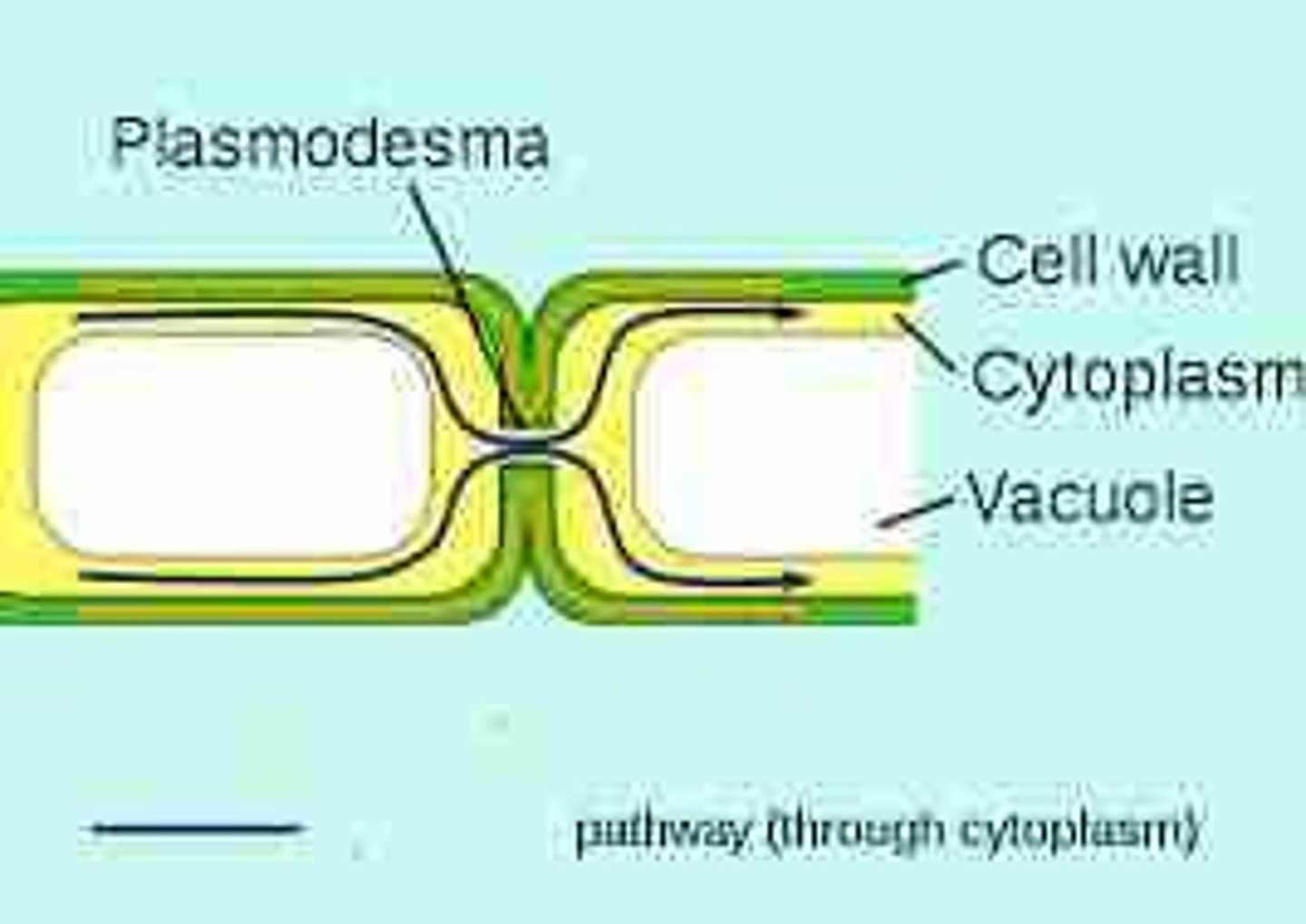
What is the apoplast pathway?
-The apoplast pathway goes through the non-living parts of the cells - the cell walls.
-The walls are very absorbent and water can simply diffuse through them, as well as passing through the spaces between them.
-The water can carry solutes and move from areas of high hydrostatic pressure to areas of low hydrostatic pressure and use water's cohesive properties to ensure a continuous flow.
-This is an example of mass flow.
-When water in the apoplast pathway gets to the endodermis cells in the root, its path is blocked by a waxy strip in the cell walls, called the Casparian strip. Now the water has to take the symplast pathway.
-This is useful, because it means the water has to go through a plasma membrane.
-Cell membranes are partially permeable and are able to control whether or not substances in the water get through.
-Once past this barrier, the water moves into the xylem.
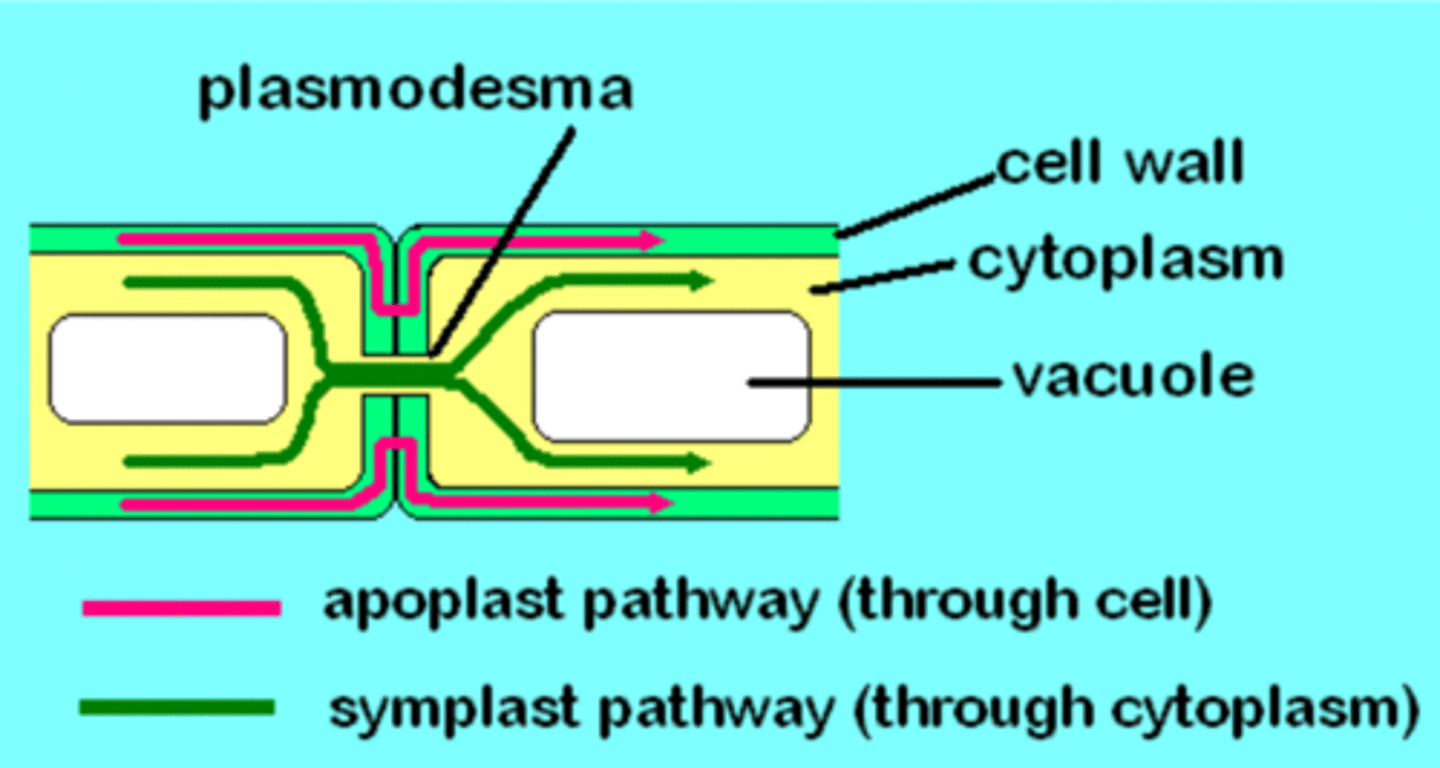
Why does the water move into the xylem?
-The solute concentration in the cytoplasm of the endodermal cells is relatively dilute compared to the cells in the xylem.
-In addition, endodermal cells move mineral ions into the xylem by active transport.
-As a result the water potential of the xylem cells is much lower than the water potential of the endodermal cells.
-This increases the rate of water moving into the xylem by osmosis.
What is root pressure?
-The active pumping of minerals into the xylem to produce movement of water by osmosis results in root pressure and it is independent of any effects of transpiration.
-Root pressure gives water a push up the xylem, but under most circumstances it is not the major factor in the movement of water from the roots to the leaves.
How is water transported through the leaves?
-Xylem vessels transport the water all around the plant.
-At the leaves, water leaves the xylem and moves into the cells mainly by the apoplast pathway.
-Water evaporates from the cell walls into the spaces between cells in the leaf.
-When the stomata open, water evaporates - it diffuses out of the leaf into the surrounding air.
-The evaporation of water from a plant's surface is called transpiration.
What is the transpiration stream?
-The movement of water from roots to leaves.
-The mechanisms that move the water include cohesion, tension and adhesion.
What are cohesion and tension?
-Cohesion and tension help water move up plants, from roots to leaves, against the force of gravity.
-Water evaporates from the leaves at the top of the xylem (transpiration).
-This creates a tension (suction), which pulls more water into the leaf.
-Water molecules are cohesive so when some are pulled into the leaf others follow. This means the whole column of water in the xylem, from the leaves down to the roots, moves upwards.
-Water enters the stem through the root cortex cells.
What is adhesion?
-Adhesion is also partially responsible for the movement of water.
-As well as being attracted to each other, water molecules are attracted to the walls of the xylem vessels.
-This helps water to rise up through the xylem vessel.
Why does transpiration happen?
-The evaporation of water from a plant's surface happens as a result of gas exchange.
-A plant needs to open its stomata to let in carbon dioxide so that it can produce glucose by photosynthesis. But this also lets water out down a water potential gradient.
-Transpiration is really a side effect of the gas exchange needed for photosynthesis.
What are the factors affecting transpiration rate?
-Light intensity.
-Temperature.
-Humidity.
-Wind.
-Soil-water availability.
How does light intensity affect the rate of transpiration?
-The lighter it is the faster the transpiration rate.
-This is because the stomata open when it gets light. When it's dark the stomata are usually closed, so there's little transpiration.
How does temperature affect the rate of transpiration?
-The higher the temperature the faster the transpiration rate.
-Warmer water molecules have more energy so they evaporate from the cells inside the leaf faster. This increases the water potential gradient between the inside and outside of the leaf.
How does humidity affect the rate of transpiration?
-The lower the humidity, the faster the transpiration rate.
-If the air round the plant is dry, the water potential gradient between the leaf and the air is increased, which increases the transpiration rate.
How does air flow affect the rate of transpiration?
-The windier it is, the faster the transpiration rate.
-Lots of air movement blows away water molecules from around the stomata. This increases the water potential gradient, which increases the rate of transpiration.
How does soil-water availability affect the rate of transpiration?
-The amount of water available in the soil can affect transpiration rate.
-If it is very dry the plant will be under water stress and the rate of transpiration will be reduced.
What is a potometer?
-A special piece of apparatus used to estimate transpiration rates.
-It actually measures water uptake by a plant, but it's assumed that the water uptake by the plant is directly related to water loss by the leaves.
How do you use a potometer?
1. Cut a shoot underwater to prevent air from entering the xylem. Cut it at a slant to increase the surface area available for water uptake.
2. Assemble the potometer in water and insert the shoot underwater, so no air can enter.
3. Remove the apparatus from the water but keep the end of the capillary tube submerged.
4. Check that the apparatus is watertight and airtight.
5. Dry the leaves, allow time for the shoot to acclimatise and then shut the tap.
6. Remove the end of the capillary tube from the beaker of water until one air bubble has formed, then put the end of the tube back in the water.
7. Record the starting position of the bubble.
8. Start a stopwatch and record the distance moved by the bubble per unit time. The rate of air bubble movement is an estimate of the transpiration rate.
9. Only change one variable at a time. Other conditions must be kept constant.
What are xerophytes?
-Plants like cacti and marram grass.
-They're adapted to live in dry climates.
-These adaptions prevent them losing too much water by transpiration.
How are cacti adapted?
-Cacti have a thick, waxy layer on the epidermis - this reduces water loss by evaporation because the layer is waterproof.
-They have spines instead of leaves - reduces the surface area for water loss.
-Cacti also close their stomata at the hottest times of the day when transpiration rates are the highest.
How is marram grass adapted?
-Marram grass has stomata that are sunk in pits, so they're sheltered from the wind. This traps moist air in the pits and helps to slow transpiration down by lowering the water potential gradient.
-It also has a layer of 'hairs' on the epidermis - this also traps moist air round the stomata, which reduces the water potential gradient between the leaf and the air, slowing transpiration down.
-In hot or windy conditions marram grass plants roll their leaves - again this traps moist air, slowing down transpiration. It also reduces the exposed surface area for losing water and protects the stomata from wind.
-Like cacti, marram grass has a thick, waxy layer on the epidermis to reduce water loss by evaporation.
What are hydrophytes?
-Plants like water lilies, which live in aquatic habitats.
-As they grow in water, they don't need adaptations to reduce water loss, but they do need adaptations to help them cope with a low oxygen level.
What are some adaptations of hydrophytes?
-Air spaces in the tissues help the plants to float and can act as a store of oxygen for use in respiration. For example, water lilies have large air spaces in their leaves.
-Stomata are usually only present on the upper surface of floating leaves.
-Hydrophytes often have flexible leaves and stems - these plants are supported by the water around them, so they don't need rigid stems for support. Flexibility helps prevent damage by water currents.
-Very thin or no waxy cuticle - they do not need to conserve water.
-Wide, flat leaves to capture as much light as possible.
-Small roots - water can diffuse directly into the stem and leaf tissue.
-Aerenchyma - allows the movement of substances like oxygen to tissues below the water.
What is translocation?
-Translocation is the movement of dissolved substances (e.g. sugars like sucrose, and amino acids) to where they're needed in a plant.
-Dissolved substances are sometimes called assimilates.
-Translocation is an energy-requiring process that happens in the phloem.
-Translocation moves substances from sources to sinks.
-The source of a substance is where it's made (so it's at a high concentration there).
-The sink is the area where it's used up (so it's at a lower concentration there).
Give an example of this.
-The source for sucrose is usually the leaves, and the sinks are the other parts of the plant.
-Some parts can be both a sink and a source - sucrose can be stored in the roots. During the growing season, sucrose is transported from the roots to the leaves to provide the leaves with enough energy for growth.
How do enzymes maintain a concentration gradient from source to sink?
-They change the dissolved substances at the sink by breaking them down or making them into something else.
-This makes sure that there's always a lower concentration at the sink than at the source.
-E.g. In potatoes, sucrose is converted to starch at the sink areas, so there's always a lower concentration of sucrose at the sink than inside the phloem.
-In other sinks, enzymes such as invertase break down sucrose into glucose and fructose for use by the plant.
What is the mass flow hypothesis?
1. Source - active transport is used to actively load the solutes into the sieve tubes of the phloem at the source. This lowers the water potential inside the sieve tubes, so water enters the sieve tubes by osmosis from the xylem and companion cells. This creates a high pressure inside the sieve tubes at the source end of the phloem.
2. Sink - at the sink end, solutes are removed from the phloem to be used up. This usually happens by diffusion because the solutes are at a higher concentration in the phloem than they are in the surrounding tissue at the sink. The removal of solutes increases water potential inside the sieve tubes, so water also leaves the tubes by osmosis. This lowers the pressure inside the sieve tubes.
3. Flow - the result is a pressure gradient from the source end to the sink end. The gradient pushes solutes along the sieve tubes towards the sink. When they reach the sink the solutes will be used or stored.
-The higher the concentration of sucrose at the source, the higher the rate of translocation.
What is active loading?
-Active loading is used at the source to move substances into the companion cells from surrounding tissues, and from the companion cells into the sieve tubes, against a concentration gradient.
-Sucrose is moved to where it needs to go using active transport and co-transport proteins.
-Co-transport proteins are a type of carrier protein that bind two molecules at a time. The concentration gradient of one of the molecules is used to move the other molecule against its own concentration gradient.
-In active loading, H⁺ ions are used to move sucrose against its concentration gradient.
How does active loading work?
1. In the companion cell, ATP is used to actively transport hydrogen ions out of the cell and into surrounding tissue cells. This sets up a concentration gradient.
2. An H⁺ ion binds to a co-transport protein in the companion cell membrane and re-enters the cell (down the concentration gradient). A sucrose molecule binds to the co-transport protein at the same time. The movement of the H⁺ ion is used to move the sucrose molecule into the cell, against its concentration gradient..
3. Sucrose molecules are then transported out of the companion cells and into the sieve tubes in the same process.
-ATP is one of the products of respiration. The breakdown of ATP supplies the initial energy needed for the active transport of the H⁺ ions.
